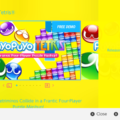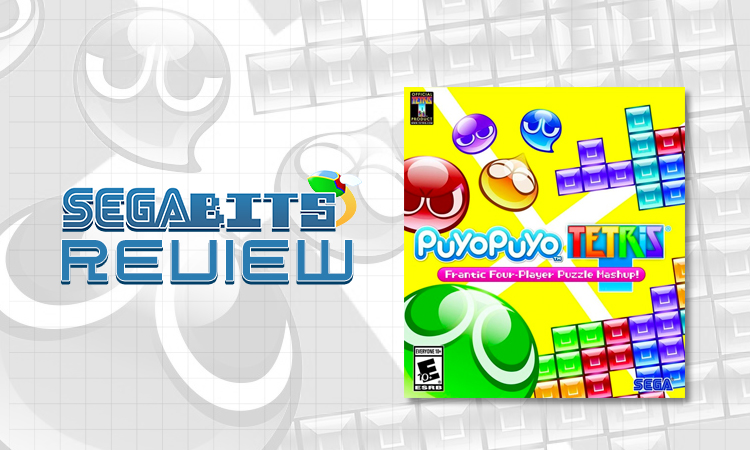
A Puyo Puyo game, released in the west. Such a strange sentence to type out in the context, due to the Puyo Puyo franchise being one of those notorious cases of a series being stuck in Asian shores with maybe the rare localized title or import title that quickly comes and goes. The last time a major Puyo Puyo game was in American and European territories was the 2004 title Puyo Pop Fever, and since then the series has been quiet. Aside from the occasional table scraps like the port of Puyo Puyo Tsu on the Wii Virtual Console, the version of Puyo Puyo Tsu in SEGA 3D Classics Collection, and the Puyo Puyo 39 minigame in Hatsune Miku: Project Mirai DX, the series has otherwise been absent.
But that all changed with Puyo Puyo Tetris, a game that has existed since 2014 on multiple systems. Unlike other Puyo Puyo games prior, Puyo Puyo Tetris gained notable attention in western territories for years. It might be a case of a silver lining in an otherwise rough year for SEGA or the controversial practices the Tetris brand has been associated with, or just it being a very fun game, but regardless Puyo Puyo Tetris was requested for localization for quite a while. But now it is 2017 and we finally have the game in western shores, more specifically for the popular Playstation 4 and Nintendo’s recently released Nintendo Switch.
After such a gap between the game’s original launch in 2014 and the 13 years since the last time a major Puyo Puyo title was released in the west, is Puyo Puyo Tetris the comeback that has been long overdue, or was there a reason why western fans were were denied Puyo Puyo for so long?
Story
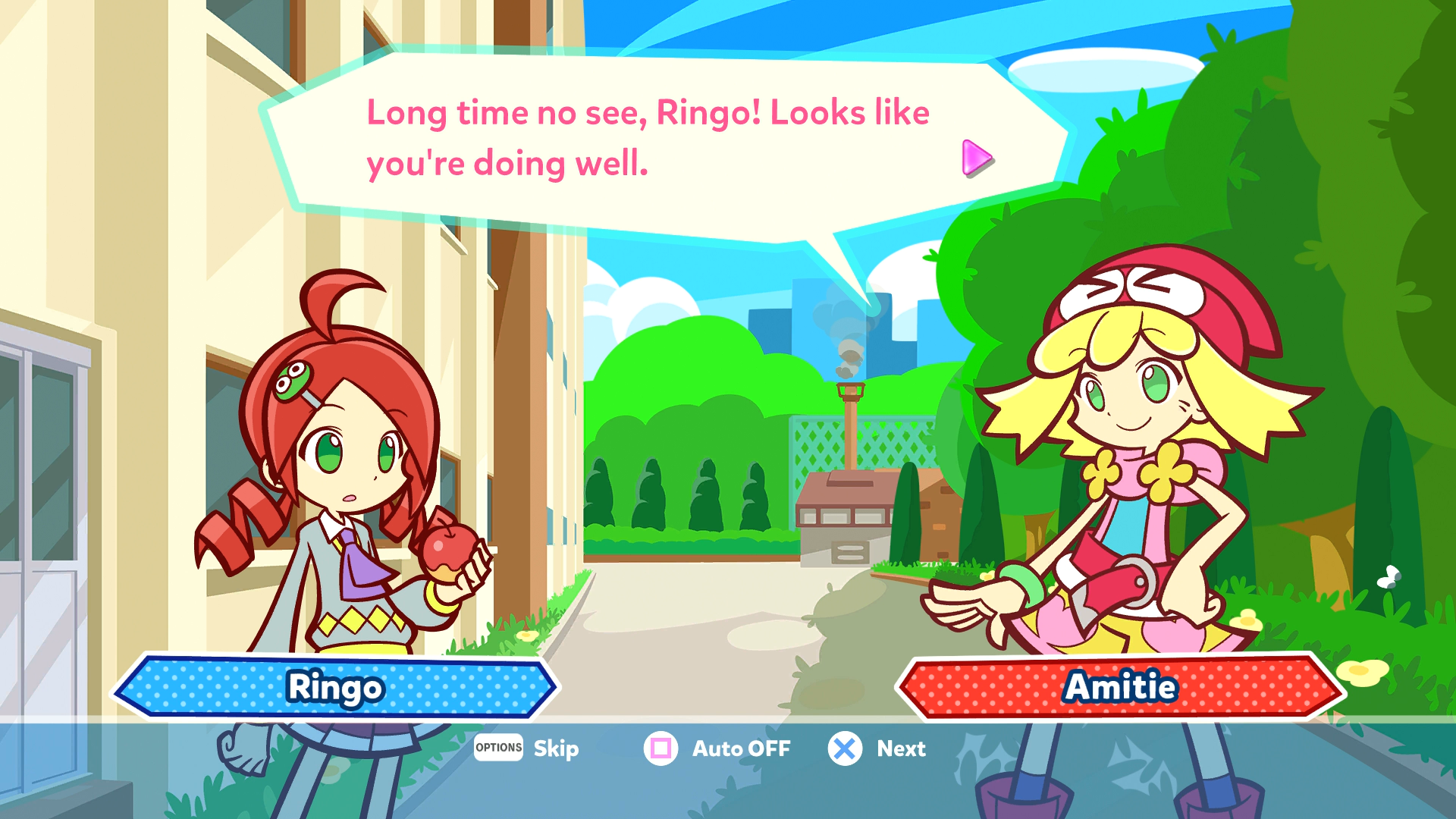
Now you may have noticed that so far in the article I mainly talk in the context of Puyo Puyo despite it also being a Tetris game. This is because at it’s core, it’s still a Puyo Puyo game, and the Adventure Mode is one of the key reasons why. More specifically, the Adventure Mode is structured as a single long adventure, with the main story lasting 7 chapters with each chapter having 10 stages each. In addition there are 3 bonus chapters that act as their own contained stories once the main adventure is cleared.
The Adventure Mode starts off by introducing several of the “main” characters, Ringo, Amitie, and Arle with Carbuncle. Ringo is enjoying her time, but suddenly meets up with Amitie, Arle, and Carbuncle, who accidentally enter Ringo’s world because of an accident when playing Puyo Puyo. Naturally the three heroines decide to play a quick game of Puyo Puyo, but then get interrupted by Tetrimino suddenly falling from the sky. The girls then suddenly get sucked away to another location.
Meanwhile, Captain of the Starship Tetra Tee and his partner O are doing their daily captain’s report. At first everything seems normal, but notices a sudden rumble and yelling in the ship, prompting both to investigate. The screaming turns out to be coming from Ringo, naturally panicking that she somehow ended up on the Starship Tetra. After Tee and Ringo discover what Puyo Puyo and Tetris are respectively, the rest of the crew members are introduced and Arle and Amitie are found. However things start to take a downhill path when it turns out the Starship Tetra started to malfunction because of Puyos randomly appearing in the ship. Despite the efforts of the crew to prevent disaster, the Starship Tetris crashes anyway and the landing separates the crew.
The rest of the story won’t be spoiled in this review, but without mentioning specific details, you’ll quickly discover the major problem with the story is the fact it’s plagued with filler. The game tries to stretch out the story to fill over 7 chapters, and it shows where characters and plot elements are introduced and just as quickly leave, causing moments where you have an empty feeling or question the purpose of the plot to begin with. Oh and if you’re a fan of specific characters, you’ll quickly learn that certain ones feel like they were included into the story just for the sake of being included. In particular there’s are specific points in the story where the solution should of been revealed and the story would of ended a lot quicker, but the writers decided to prologue it further through arbitrary reasons. It’s a nitpick in hindsight considering the story is not complicated to begin with nor does it try to, but it’s still technically a problem regardless.
As for the cast of characters themselves, we have an interesting blend. Obviously because Tetris doesn’t have a cast of characters aside from the odd experiments like in Tetris 2 or Tetris Battle Gaiden, a new bunch of characters were made specifically for this game. We have the serious captain Tee, his partner and sort of mascot for the Starship Tetra O, the bratty Ess, the dutiful house aide/security robot Zed, the smart yet skittish Ai, the mischievous twins Jay & Elle, and the mysterious Ex. Along with these new characters we have old returning favorites from the Puyo Puyo side of thing, such as the likes of Arle, Amitie, Ringo, Draco, Schezo, Sig, Raffina, Satan Dark Prince, and so on. Liking these characters hinges on whether or not you are cool with straightforward quirky personalities. They don’t dwell into deep philosophical concepts and some would argue several of them are cliches, which for the type of game Puyo Puyo Tetris is works fine. However in Puyo Puyo fashion there’s a sense of light-hearted comedy with the cast, even when in the more dire moments. You’re likely to find charm with how these characters interact with each other despite being rather basic and will likely gravitate to at least one favorite. But again, if you have a particular favorite character, there’s a chance you won’t see them much in the adventure mode. If this was like Puyo Puyo! 15th Anniversary or Puyo Puyo 20!! Anniversary where every character had their own story scenario, this wouldn’t be an issue. But alas, that’s not the case.
A localization specific problem also comes up when you consider the lack of context. Since the last game released in the west was Puyo Pop Fever, this may cause people to get lost when characters or elements introduced between Puyo Puyo Fever 2 and Puyo Puyo!! 20th Anniversary appear and not get elaborated on. For example, Ringo at one point complains about that they recently went on a Puyo Puyo adventure and she doesn’t want to go on another one. If you have absolutely no knowledge of the Puyo Puyo series, a random statement like that can be confusing. Who are you and what adventure are you blabbering on about? Now obviously for fans of the series this won’t be a problem since they’ll understand these elements, but for the people that are likely to start getting into the series with Puyo Puyo Tetris, there is a risk of being lost with certain details.
After you beat the main story, you’ll get an additional 3 chapters dubbed the “EX” chapters. Unlike the first 7 chapters, these EX chapters are their own contained story. The obvious advantage of this is that since they are independent stories, the writers have the flexibility to write whatever they wanted without causing a sloppy stretched out pacing. Another advantage of the EX chapters is that it gives certain characters more screen time they would otherwise have no time for. While completely optional, it’s still recommended to go through the EX chapters since they provide you with additional bonuses to unlock.
Presentation
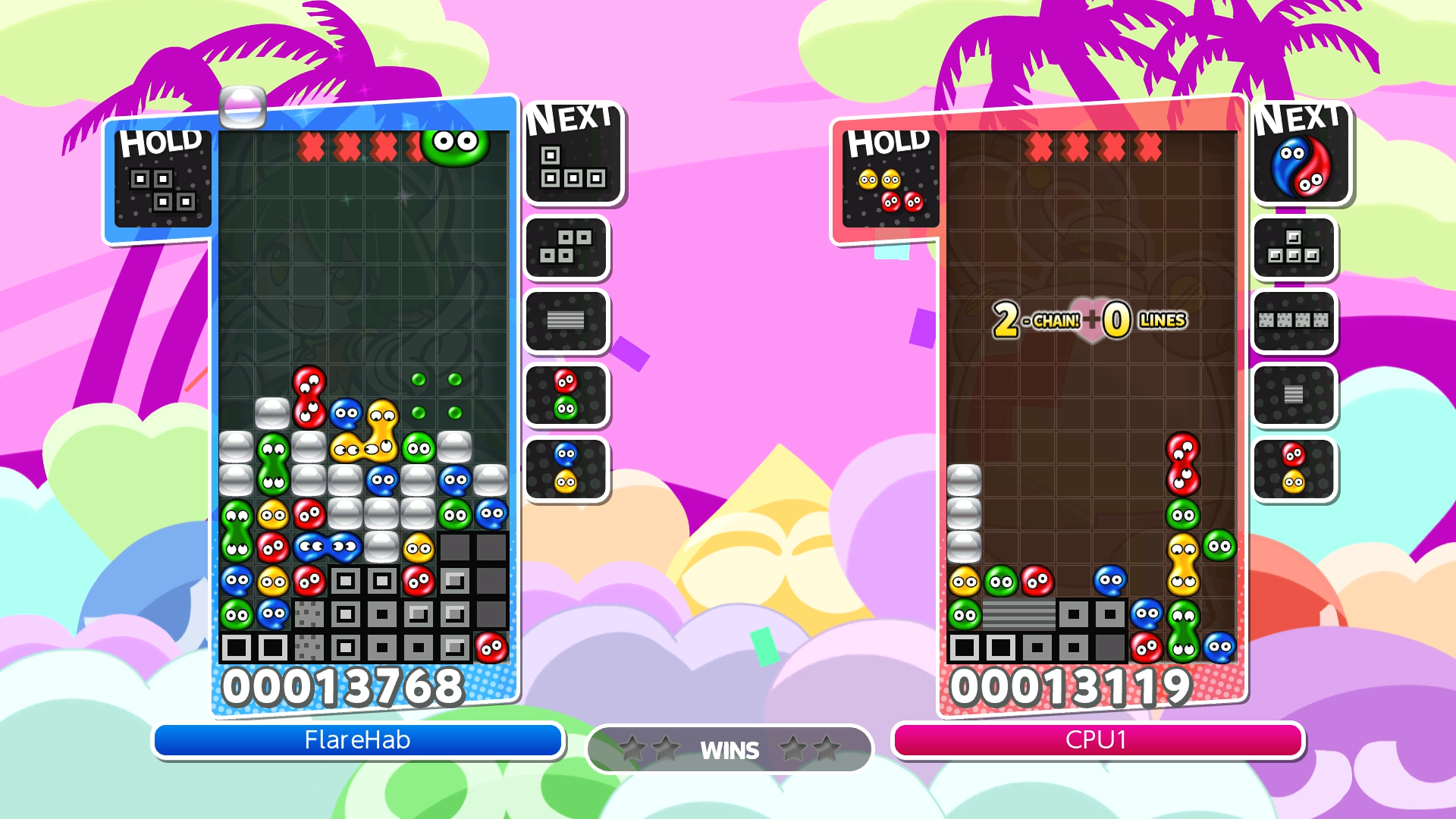
When it comes to the presentation, there’s a mixture of positives and negatives, but it’s not unique to Puyo Puyo Tetris. Puyo Puyo games starting with Puyo Pop Fever adapt a simplistic flash-esque animation style, meaning that characters are composed of different parts that are manipulated to give off the illusion of movement. However there are times where characters don’t animate at all, predominately during story mode cutscenes, but earlier games also has this issue during matches too. This ultimately creates the biggest problem with the presentation, is that it’s obvious that there’s a small budget and the developers can’t get away with a lot. Characters barely animate, there’s nothing like big grand bosses or landscapes to invoke a sense of size, there’s no flashy lighting or particle effects, there’s not even any polygons used whatsoever.
Let me iterate that this is not a problem exclusive to Puyo Puyo Tetris, and is not the worst example of this limitation in action for the series. Puyo Puyo 7 is probably the worst example of this limitation in action and contributes to the game’s rushed vibes. But when you start to realize games that adapt a similar “flash” style of animation like for example Shantae Half-Genie Hero or Tembo the Badass Elephant have more actual animation put into it, you’ll start to notice how Puyo Puyo Tetris looks limited.
However, there are still a few strengths to the presentation. Puyo Puyo Tetris being based on Puyo Puyo is a very colorful game, not being afraid to show off a wide arrange of bright colors on your screen, and because of this the game pops out even when glanced from a distance. This is further enhanced by Puyo Puyo Tetris being the first game in the Puyo Puyo series to adapt 1080p resolution, meaning that everything is very clean on the big screen. Even if you view it at 720p on the Nintendo Switch’s portable screen it still looks bright, colorful, and clean. Also because the game is based on Puyo Puyo, naturally there’s going to be a lot of personality to make the game feel more memorable. Every character has their own set of animations and voice clips, there are Puyo and Tetrimino skins you can unlock, and there’s a selection of music and backgrounds, with options to cater to those details.
The simplicity also has the hidden benefit of having fantastic performance across the board. Puyo Puyo Tetris runs amazingly on the Nintendo Switch and the Playstation 4, both running the game at 1080p and 60FPS with no compromises whatsoever. No 30FPS, no 60FPS that constantly drops, no shifting between 30FPS and 60FPS, and no resolution drops, throughout the entire game you will have a smooth experience. This is especially important for the type of game Puyo Puyo Tetris is, since you won’t have to worry about a sudden frame rate drop eating up your inputs and potentially costing you a match. Also because of the simplicity with the game, load times are very fast, so you can easily jump in and out of menus and matches with no time wasted. However there is a minor trade off though with the performance and presentation in one instance. 3 or 4 player matches simplify the animations of all the characters further for the sake of keeping that consistent frame rate. However it’s minor enough that you won’t notice it.
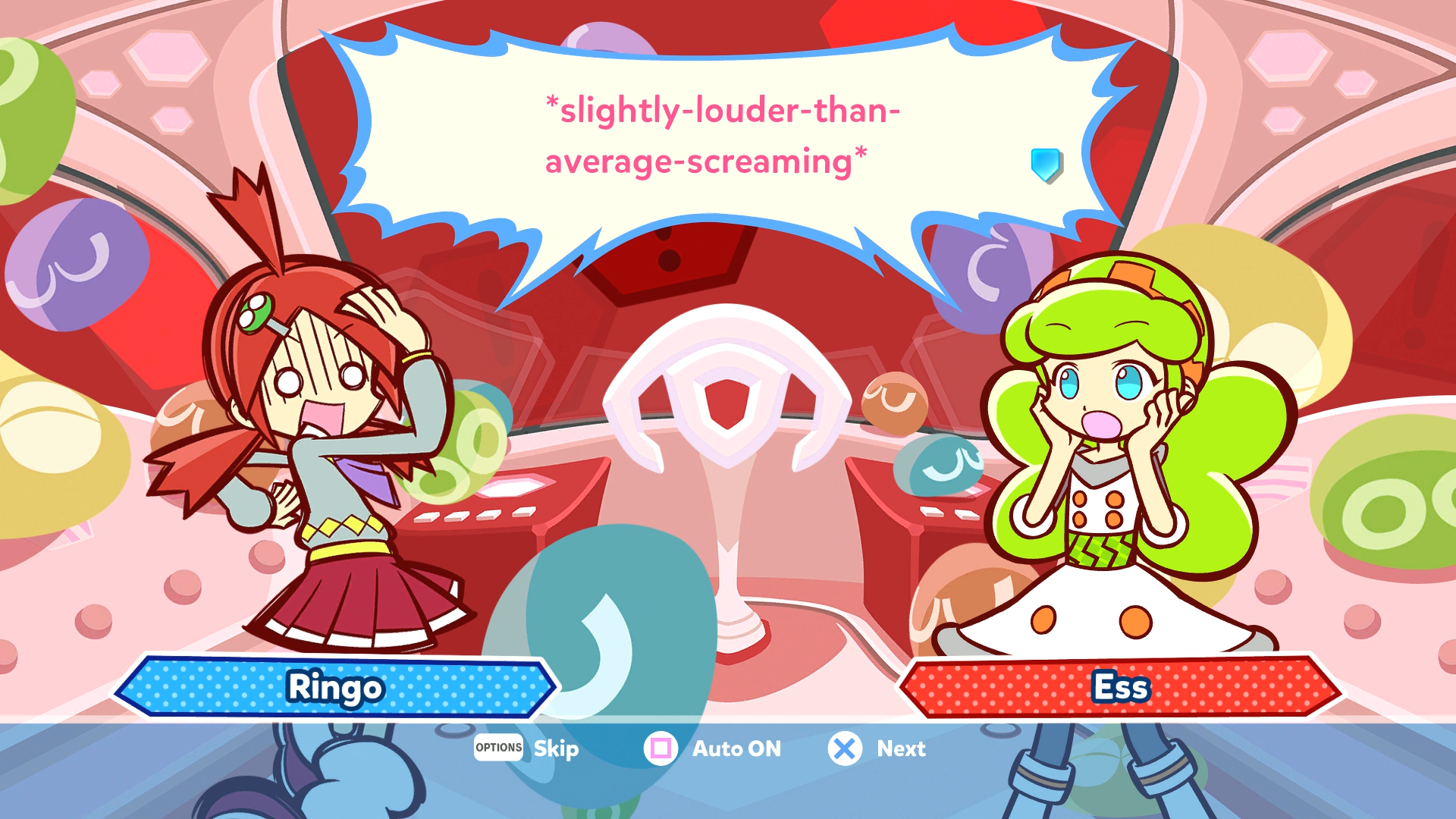
But now it’s time to get into the most subjective aspect about the presentation, which is the voice acting. This is probably where opinions are going to be the most split up because there are some highlights but also some problems. Puyo Puyo Tetris in particular has a dub, a detour from SEGA’s more niche titles retaining the Japanese voices, along with there being no dual audio option. This is also notably the Puyo Puyo franchise’s second time having a dub, the first time being with Puyo Pop Fever.
The good news is that unlike Puyo Pop Fever, familiar actors are hired that commonly voice for anime and video games, so right from the get go there is “standard” talent on board to voice the characters. Whether or not the choices made are good or not is based on opinion. Some of the English voices retain a similar direction to their Japanese equivalent, while others go for a different interpretation. For example, the characters Tee, Sig and Klug are voiced by males in the English version, compared to the Japanese version where they were voiced by women, overall making them sound older. Personally speaking, most of the English voices work, the main issues with the dub are that Carbuncle sounds forced and Klug is too obnoxious. But the Japanese version had it’s own share of questionable voice directions, like Draco being really high pitched to the point of being super annoying, so it’s a fair trade off.
Regardless of what language you listen the voices in, there is a notable problem with the voice clips getting repetitive. During matches characters will shout out the same “attacks” or comment on getting injured, and it’s always consistent. From a gameplay standpoint this makes sense since the voice clips can provide passive insight into how big your opponent’s chain is going to be or if they are receiving garbage, but this comes with the side effect of characters repeating the same voice clips a lot. Naturally this problem becomes more apparent depending on which characters you face. For example a character like Klug will really grate on your ears from the repeated shouting of “Awaken!” during matches.
But again, the voices are by far the most subjective part of the presentation. Depending on who you are you might really like the voices, hate the voices, or have a neutral opinion. From my prospective at least, there’s strengths and weaknesses in both English and Japanese voice directions, but someone else might think one is a lot better then the other. But either way, there is an annoyance factor due to the repetitious voice clips during matches. The repetitive voices are not an exclusive problem to Puyo Puyo Tetris, but are still notable enough to mention.
Gameplay
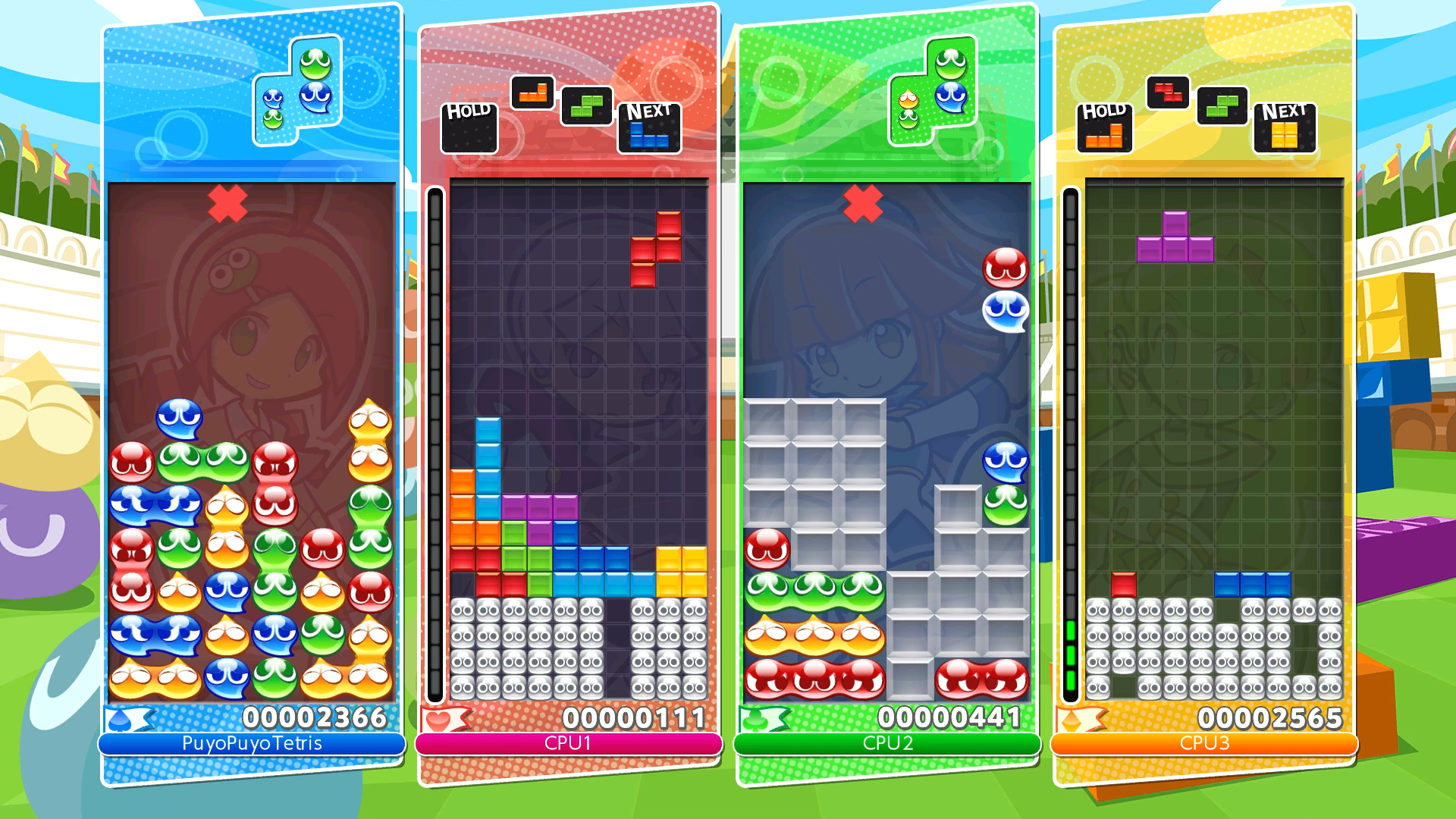
It’s Puyo Puyo and Tetris, mixed together. The concept itself is interesting since puzzle game crossovers like this are rare, the only other example really is Tetris & Dr. Mario for the SNES released in 1994. Now the obvious question is how would combining two fundamentally different games work together. Puyo Puyo Tetris answers to this by introducing a set of exclusive modes that highlights both types of gameplay.
If you are not familiar with either Puyo Puyo or Tetris, here’s a quick rundown. Puyo Puyo involves dropping colorful blobs in pairs (with exceptions) in a limited board, typically 6 x 13 with the 13th row being hidden row. The objective is to create chains by either wedging different colors or dropping them in patterns to create a chain reaction. The large the chain, the more garbage inflicted. Tetris meanwhile deals with 6 different types of blocks called Tetrimino. The objective is to clear lines by filling up rows, while maybe preforming the occasional T-spin or similar types of spins.
Versus is the most basic mode regarding to multiplayer. You can choose either Puyo Puyo or Tetris, more specifically Puyo Puyo based on the recurring Puyo Puyo Tsu rule set and Tetris based on the standard Tetris Guideline established since 2001. Which one you choose has their own strengths and weaknesses on a basic level. Puyo Puyo is arguably more flexible, allowing you to toy with different chains and adapt to the situation at hand, while Tetris is more about the speed and setting up to quickly flood the opponent’s side. When it’s Puyo Puyo vs. Puyo Puyo or Tetris vs. Tetris, it’s exactly what would expect for a normal game of either. Puyo Puyo vs. Tetris however adds a unique spin to both styles and highlights the fundamental differences between the two. On the Puyo Puyo side you have a loose goal of trying to create a large chain, but on the Tetris side they can easily pepper the opponent with layers of garbage to hinder the Puyo player. Because of this it can create a unique pacing not found in any other game, a sort of “tug of war” for a lack of a better word.
Of course just a straightforward Puyo vs. Tetris mode would not be enough to hold a game, which is why there are additional modes that toy with the concept further. Swap which forces the player to switch between Puyo Puyo and Tetris, Fusion which literally mixes Puyo Puyo and Tetris together, Party where you utilize powers to either benefit yourself or hinder the opponent while trying to get the highest score within a time limit, and Big Bang where the objective is to clear as many chains within a time limit and damage your opponents. There are also 6 endless modes. A standard Puyo Puyo and Tetris endless mode, Endless Fever which you have to clear as many Puyo chains as possible within a time limit, Tiny Puyo has a much larger board by giving the player tiny Puyos, Marathon where you clear 150 rows of Tetriminos which gradually gets faster, Sprint where you clear 40 lines as fast as possible, and Ultra where you have to get the highest score possible within 3 minutes.The modes also come with a set of customization options. You can change the cosmetics of a match by changing the music, background, Puyo skins, and Tetrimino skins.
There are handicap options that can hinder or benefit players, ideal if you are concerned over the skill levels of players and want to help even out the gap. Finally there’s miscellaneous options such as setting up how big a Puyo chain needs to be in order to send garbage or how high or low you want to set Margin Time.
All these modes allow you to pick one of the 24 playable characters before a match, and most allow you the choice to play either Puyo Puyo or Tetris. Depending on the mode, the characters may either be purely cosmetic or have gameplay influence. An example is the recurring character specific dropsets, utilized when playing in specific modes like Fusion or Party. Every character also has their own AI when set to CPU, naturally causing some to play stronger then others or gamble with “gimmick” patterns. Of course if you have the guts or just hate your life, you can activate the Core AI cheat by holding L1 before selecting a CPU, which will cause the opponent to play at their strongest.
You may notice that compared to some Tetris or Puyo Puyo games, the quantity of modes is more limited. For some that are savvy with either franchise, this can come off as disappointing. But on the flip side, most of these modes are exclusive to Puyo Puyo Tetris, and the low number of modes is compensated by the combination of Puyo Puyo and Tetris. For example in Party mode, there are powers that are exclusive to Puyo Puyo and Tetris, while Big Bang has slightly different rules when it comes to clearing out the preset boards.
Now naturally some would assume this is one of those “quality over quantity” deals where there are less modes but the modes are top notch, but that’s not the case. More specifically modes like Party and Fusion feel like they were not as thought out, with Party being potentially frustrating due to the powers and Fusion being a bit of a mess. Swap however is a pretty fantastic mode that takes advantage of both Puyo Puyo and Tetris in possibly the best way, and Big Bang can get tense, even if it does suffer from the “annoying voice clips” problem mentioned above the most. But even if personally speaking not all the modes are winners, they still feel more fleshed out then some of the questionable modes found in other games, so in that regard they do their job.
Of course for the novices, there’s a useful tutorial section to help improve yourself. This tutorial section goes into detail with both Puyo Puyo, Tetris, and Fusion, further divided by three categories with Basic, Advance, and Strategies. These lessons vary, from the basics such as how to rotate and manual drop, to concepts such as transitioning a Puyo chain or preforming a T-Spin in Tetris. The only issue is that there is no challenges to help you learn these lesson through trial and error, so you’ll have to do that on your own in another mode.
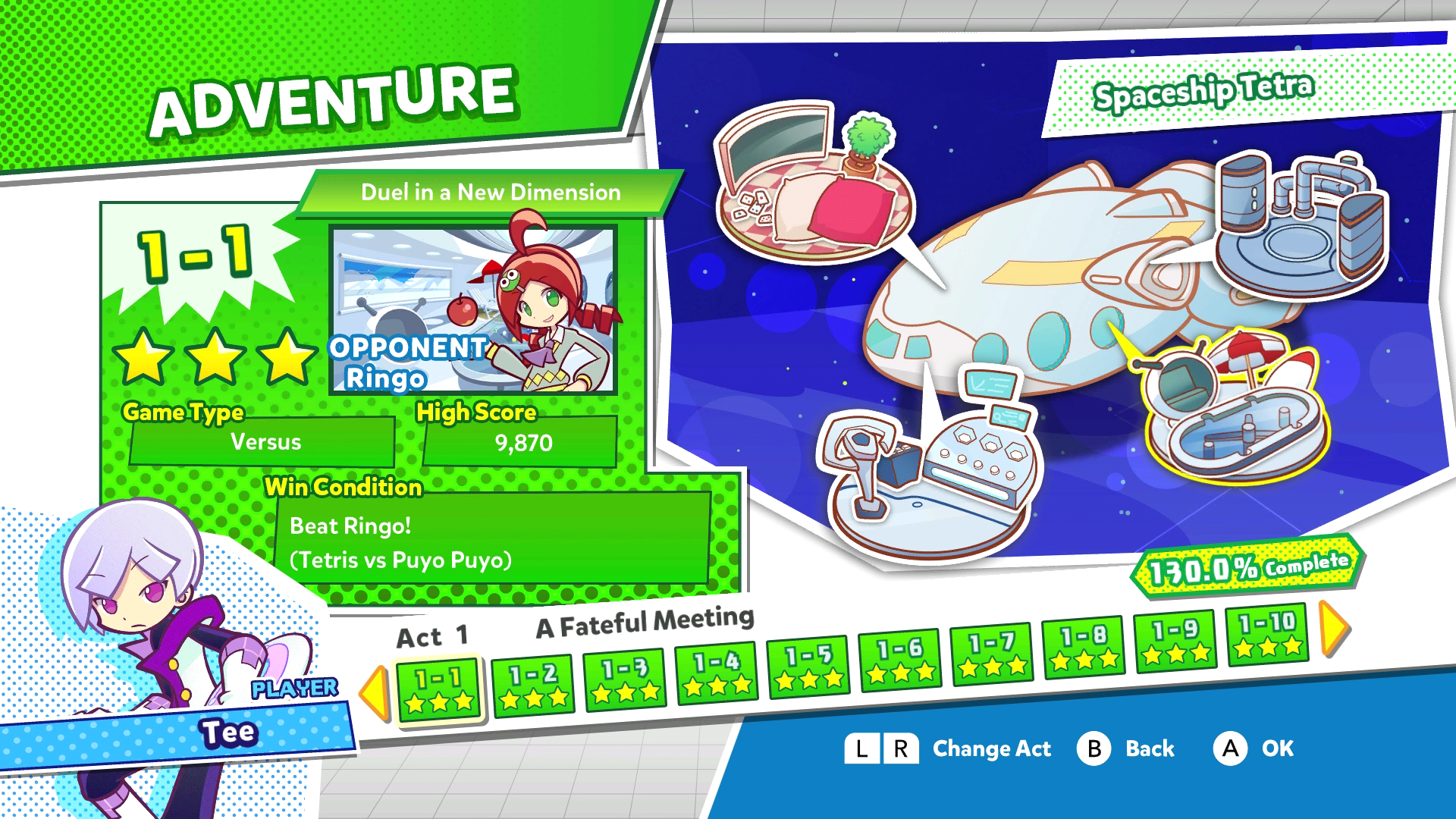
Another alternative is to play through the Adventure Mode. The Adventure Mode aside from the plot also serves as a series of challenges,10 chapters total with 10 stages each, overall meaning that there are 100 stages to tackle. The difficulty doesn’t get dramatically hard over the story, being just easy enough for intermediate players to get through and you can try each stage as much as you want. However, if you do lose a particular challenge too many times, you’ll eventually get the option to skip over the stage. Of course if you plan on getting 100%, this is not recommended. The main difficulty will come from the “boss” fights at the end of chapters, where the AI becomes smarter than usual. The true challenge is trying to earn 3 star ranks on every stage. By default you’re guaranteed to earn 1 star from completing a stage, but you may also earn 2 or 3 stars depending on your performance. The criteria is either based on the score or the time, but the former has the problem of it being too easy to earn if you play “badly” by farming for points. If you don’t care about the rankings, then don’t worry, since it’s completely optional.
Each stage provides some type of goal, either simply beating the opponent or fulfilling some type of score quota in an Endless mode. Every chapter loosely follows a theme when it comes to what mode it focuses on. For example Chapter 5 puts more focus on Big Bang while Chapter 7 focuses on Fusion. This means that chapters tend to be consistent, so you know exactly what to expect. But if you hate Puyo Puyo or Tetris or a specific mode, we’ll you’re forced to play whatever they provide you. Luckily there’s no situation where you’re forced to do any Tetris The Grand Master-tier tasks.
Playing through the Adventure Mode is also important to unlock additional content. You’ll unlock new music tracks and backgrounds as you start out, but later starting with Chapter 4 you’ll start unlocking more characters, and playing through the EX chapters unlocks additional Puyo and Tetrimino skins, music, alternative voices, and backgrounds. You can also unlock additional content through an in-game shop that uses “Credits”. Credits are earned whenever a match ends; even worst case scenario of losing a match earns you at least 1 point. How much credit you get depends on your performance, how many opponents you fight, and what mode. Once you earn enough credits, you can buy alternative skins for Puyos and Tetriminos, and alternative voices.
If you have to get this game, make absolute sure you have plenty of friends and family, because multiplayer is by far the biggest strength of this game. In the same way you might gather people for a round of, say, Bomberman, Mario Kart, or Super Smash Bros., Puyo Puyo Tetris is the type of game that can be a fun time with a crowd both for the casual and the competitive. Luckily there are both local and online selections to choose from, so it’s easy to jump on board and play with other players. For the latter, you have the option between the “Puzzle League” which is a ranking match where you battle against other opponents to increase your ranking or defend your ranking, and a “Free Play” more where you can play any mode with no restraints. There’s also replays where you can save and share matches online, so if you had a particularly awesome match, don’t be afraid to share it to others.
Nintendo Switch vs. Playstation 4
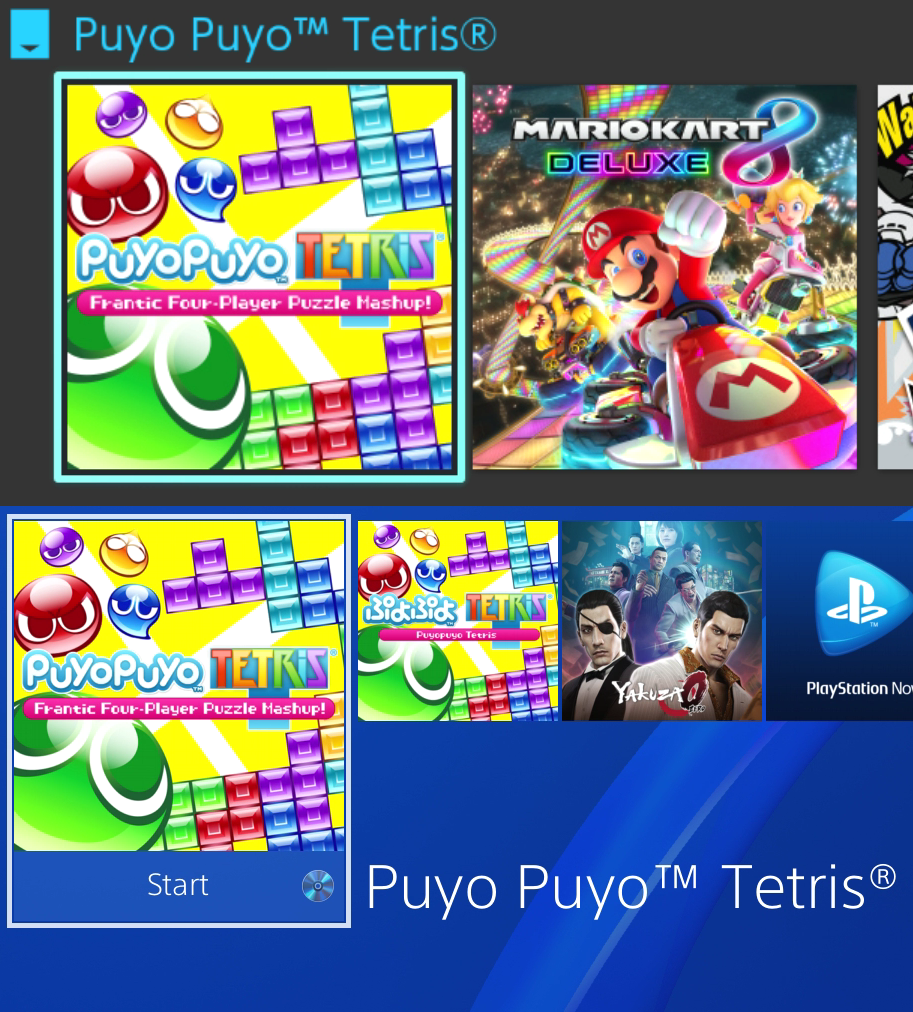
Now a question that might be brought up is which version of Puyo Puyo Tetris is the better deal. An important thing to remember is that, regardless of which version you get, it contains the same amount of content. The same characters, modes, music, backgrounds, Puyo/Tetrimino skins, and so on. It’s also worth noting that the PS4, Xbox One, and Nintendo Switch versions were originally “deluxe” versions that contain all the DLC and some alternations to the music, balance, and graphics. This also applies to the localized versions, meaning you are getting the full game out of the box regardless.
Between the PS4 and Nintendo Switch versions specifically, the games are on the surface identical. Both versions have the same graphics and sounds, and both are designed to run at 1080p 60FPS (720p if playing on the Switch’s portable mode). The Switch version (at least the physical copy) has a slightly slower loading time compared to the PS4 version, though it’s still fast enough that you won’t notice it much. However, the differences become more apparent once you take into consideration the hardware itself.
The Nintendo Switch version has the advantage of versatility. The Nintendo Switch itself is designed to be a jack of all trades, being able to have console quality games both from your television and on the go. Also the Nintendo Switch, because of the Joy Cons, comes with the ability to play local multiplayer games right out of the box for at least two players. This means that the Nintendo Switch version is arguably the best version of Puyo Puyo Tetris, due to the Nintendo Switch hardware taking advantage of both Puyo Puyo’s and Tetris’ most notable strengths: multiplayer and portability. To further emphasize this point, the Switch version has a “quick play” option on the title screen where you can instantly start a Puyo Puyo, Tetris, or Fusion match with no hesitation.
One particular detail worth mentioning is the HD Rumble feature. While a minor detail in hindsight, there are some clever uses for the feature. It’s completely optional, but there are subtle stuff like how every piece dropped causes a slight shake, or how the explosion in Big Bang causes the Joy Cons to shake wildly. Even cutscenes are effected by the HD Rumble, like how the Joy Cons will start shaking when a character is being scary or being shocked.
There is a slight disadvantage with the controls though. Specifically the Joy Cons while allowing for two players out of the box, can feel slightly too sensitive when controlling Puyos or Tetriminos. Tetris in particular might feel awkward and there will be points where you accidentally quick drop and screw yourself over. It’s not enough to ruin the game, mainly because you’ll only notice it when you are controlling the Tetriminos or Puyos using the Joy Cons control stick, which honestly feels too slippery in general.
Now, by comparison, the Playstation 4 version is more restricted in that regard. Sure you’re getting the same game, but you lack the ability to take the console anywhere and local multiplayer is more difficult to set up. There is however one notable advantage of getting the PS4 version, which is the asking price. Puyo Puyo Tetris on the Nintendo Switch asks for a price of $40, but by comparison the PS4 version is $30, at least if you plan on getting a physical copy. Regardless the asking price is still cheaper then a typical AAA title on the market, but if you are still too nervous about spending too much money, then the Playstation 4 version will save you at least $10. Also generally speaking the PS4 has a larger base then the Nintendo Switch, so statistically speaking people are more likely to get the PS4 version due to it having a wider audience.
Aside from those details, there’s no compromise between versions. So which ever version you get, you’ll get a similar experience. But between the two, the Nintendo Switch version is the better package.
Even with some of it’s flaws, the game still plays strong because it offers what it says on the label. A fun combination of Puyo Puyo and Tetris, no compromises between either. Fan, fun, smooth, it’s a great way to play both solo and with friends or family. It’s also at a really reasonable price, so there’s no worry about not getting your money’s worth. Please pick up a copy, because your time will be worth it!
Positive:
- Bright and colorful presentation enhanced by the high resolution.
- Multiplayer is fantastic.
- Very fast and smooth performance overall.
- Story has entertaining moments.
Negative:
- Presentation has some “low budget” problems.
- The story has pacing problems.
- Slightly less modes than other Puyo Puyo and Tetris titles.
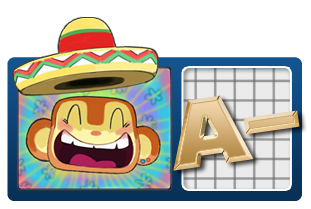 “Puyo Puyo Tetris is a fantastic game for both the Nintendo Switch and PS4, a fun puzzle game with colorful characters and fast addicting gameplay.”
“Puyo Puyo Tetris is a fantastic game for both the Nintendo Switch and PS4, a fun puzzle game with colorful characters and fast addicting gameplay.”



